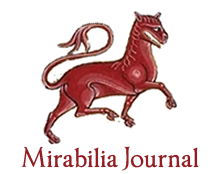Sister Isabel de Villena: from religio amoris to amor religionis
Antonio CORTIJO OCAÑA
Original title: Sor Isabel de Villena: de la religio amoris al amor religionis
Published in Isabel de Villena (1430-1490)
Keywords: Amor religionis, Love literature, Religio amoris, Sor Isabel de Villena, Vita Christi.
The Vita Christi by Sor Isabel de Villena was written for the nuns of the Monasterio de la Trinidad in Valencia. The female readership would have felt an immediate affinity with some of the female characters in this work (Virgin Mary, Mary Magdalen). These characters and their love for Christ are presented with a technique and emphasis that imitates that of other love narratives from the same period. Although diverse in context and intention, all these works share a new relevance given to affectivity when dealing with love as a theme, thus helping blur the boundaries between religio amoris and amor religionis.
Social Relations of Prior Vasco de Ataíde: The Priory of Crato of the Order of the Hospital from 1453 to 1491
Dirceu Marchini NETO
Original title: As Relações Sociais do Prior D. Vasco de Ataíde: o Priorado do Crato da Ordem do Hospital de 1453 a 1491
Published in Manifestations of the Ancient and Medieval World
Keywords: Battle of Toro, Order of the Hospital, Portugal, Priory of Crato, Vasco de Ataíde.
This article analyzes the social relations that involved the Priory of Crato of the Order of the Hospital in the days of D. Vasco de Ataíde, between the years 1453-1491. The Priory of Crato was the Portuguese branch of the Order of the Hospital of St. John of Jerusalem, a religious and military order. The text presents a study about the family Ataíde, about the bond of this family with the kings that governed Portugal during the analyzed period. It also presents an analysis of the people who composed the prior's house of this prior and the alliance made between D. Vasco de Ataíde and the hospitaller prior of Castile on the occasion of the Battle of Toro.
Some remarks on Plato on emotions
Robert ZABOROWSKI
Original title: Algunas observaciones de Platón a respecto de las emociones
Published in Emotions in the Ancient and Medieval Mediterranean World
Keywords: Desiring linkage, Emotions, Feeling, Plato, Stratification of affectivity, Thinking.
A paper is an attempt at reassessing the role of emotions in Plato’s dialogues cannot be assessed. A standard view identifying (or translating or interpreting) to logistikon with (as) reason, to thumoeides with (as) the irascible and to epithumetikon with (as) the concupiscent is challenged so far as each of the three parts possesses emotions (affectivity) of its own. The opinion that Plato is responsible for the negative view of emotion is rejected. Plato’s views on emotions are understood more accurately understood from a hierarchical perspective, i.e. when three parts of the soul are analyzed as three strata of the feeling–thinking–desiring linkages.
St. Bonaventure’s aesthetic ideas as possible doctrinal source of Trecento Italian iconography
José María SALVADOR GONZÁLEZ
Original title: Ideas estéticas de San Buenaventura como posible fuente doctrinal de la iconografía del Trecento italiano
Published in Art, Criticism and Mysticism
Keywords: Aesthetics, Iconography, Italian painting, Mariology, Patristics. Medieval Philosophy, St. Bonaventure, Trecento.
This paper attempts to highlight the influence that the primary Aesthetics designed by St. Bonaventure could have had on some paintings of the Italian Trecento. Therefore, the work is divided into two parts essentially linked. Firstly it analyzes in detail the first two levels (of the six proposed by the saint. plus a seventh of pure ecstasy), by which man can and must ascend from the world to contemplate God: on those two initial levels, linked to the sensory knowledge, man uses his sensitivity to appreciate the material things of this created world as footprints and traces of their Creator. In the second part several paintings by Giotto, Simnone Martini, Pietro Lorenzetti, Ambrogio Lorenzetti, Agnolo Gaddi and Taddeo Gaddi are analyzed, in order to see if one can perceive in them some influence of the initial phase of the Aesthetics of Bonaventure, that implies a remarkable enhancement of the physical world and the senses by which we perceive it with full cognitive validity.
Structuring the tradition in the old Catalan Literatures: from Ramon Llull (1232-1316) to Bernat Metge (1340-1413)
Júlia BUTINYÀ
Original title: Estructurant la tradició en les lletres catalanes antigues: de Ramon Llull (1232-1316) a Bernat Metge (1340-1413)
Published in The World of Tradition
Keywords: Bernat Metge, Crown of Aragon, Humanism, Middle Ages, Ramon Llull.
To contribute to structuring the tradition in the Catalan letters of the Middle Ages, links are exposed that root the thought of the great humanist, Bernat Metge, in the great medieval philosopher, Ramon Llull. This link allows us to observe the continuity that, in one way or another and with greater or lesser intensity – and often with leaps of eras-, can be seen in the different literatures. According to the present proposal of textual concomitants, in the Crown of Aragon and through both authors, the connection between tradition and modernity occurs with high intensity in the 14th century itself, right at the beginning of the change in mentality and sensibility.
Stupid, drunks and giants: satire, carnivalism and hedonism in Erasmus of Rotterdam (1466-1536) and François Rabelais (c. 1483-1553)
Mariano OLIVERA
Original title: De estultos, beodos y gigantes: sátira, carnavalismo y hedonismo en Erasmo de Rotterdam (1466-1536) y François Rabelais (c. 1483-1553)
Published in The Medieval Aesthetics
Keywords: Carnivalism, Epicureanism, Grotesque, Hedonism, Satire.
Satire was genuinely expressed as the disruptive and irritating power against the status quo of medieval and Renaissance society. A unique rhetorical and poetic element, loaded with critical expressions of a political, moral and pedagogical nature, associated with a hedonistic and impulsive vision of vitality. Consequently, related to the common and happy sense of the vulgar, the plebe “estulta” or “foolish” in front of the ascetic, the reflection and the mortified and rationalistic experience of the wise or solitary scholar. A biblical sentence illustrates it: Stultorum infinitus est numerus (“The number of fools is infinite”). Satire presents the world upside down, society upside down, the world revolutionized, happiness as foolishness. Finally, it shows us another perspective in which the pleasure and the hedonistic expression of the body have their privileged place in front of the rule and the monastic and ecclesiastical moral regulations. The writings Praise of the Madness of Erasmus of Rotterdam and Gargantúa and Pantagruel by François Rabelais (sixteenth century), mark important antecedents of satire (and its grotesque derivation) in philosophy and literature, where it is expressed in the first work a recovery of the epicurean philosophy and in the second the extreme hedonism in its grotesque character. The aim of our work is to indicate the carnivalesque-hedonistic vision and moral criticism expressed in such works.
Suger (1081-1151) and the spiritual work at the Abbey of Saint-Denis (12th century)
Tainah Moreira NEVES
Published in
Keywords: Abbey of Saint-Denis, Gothic Architecture, Medieval Philosophy, Pseudo-Dionysius the Areopagite, Suger of Saint-Denis.
This essay analyses Abbot Suger’s (1081-1151) spiritual work at the rebuilding of the entrance and the choir of the Abbey of Saint-Denis (1130/1137-1144). We based our research on his writings On the Consecration of the Church of Saint-Denis and On What Was Done under His Administration, as well as on the theology of Pseudo-Dionysius the Areopagite. Furthermore, the remnant physical structure of the church was analysed to strengthen the concepts advocated by the Abbot of Saint-Denis. Our intention was to demonstrate that in supervising the rebuilding of his abbey, Suger used Art and Architecture to communicate his spiritual beliefs based on the metaphysics of the light: the spirits would ascend from the material world, thanks to Christian contemplation, to the immaterial world, towards the Light.
Symbol and visionary experience in Hildegard of Bingen’s Epistolary (1098-1179)
María ESTHER ORTIZ
Original title: Símbolo y experiencia visionaria en el Epistolario de Hildegarda de Bingen (1098-1179)
Published in The Medieval Aesthetics
Keywords: Epistolary, Hildegard of Bingen, Symbol, Visionary experience.
Hildegard of Bingen’s epistolary gathers, in its almost four hundred letters, a very rich biographic material with XII century historic and cultural data. It also presents a particular style, closed related to her visionary gift. Inside the exploration of this mundus imaginalis, a real aesthetic experience takes place: the symbols constellations that appear in these texts (mainly from nature) correspond with similar images from other languages used by Hildegard such as pictorial and musical ones. By means of some examples, this article inquires to what extent and in which way this perspective broadens the hermeneutic horizon in the epistolary texts.
Tamerlane’s female court. Sensory and power from the perspective of Ruy González de Clavijo (1403-1406)
Laura CARBÓ
Original title: La corte femenina de Tamorlán. Sensorialidad y poder desde la perspectiva de Ruy González de Clavijo (1403-1406)
Published in Senses and sensibilities in classical and medieval worlds
Keywords: 15th century, Embassy to Tamerlan, Materiality, Power, Senses.
Ruy González de Clavijo starred, together with a team of ambassadors, the second mission sent by Henry III of Castile to Tamerlan in 1403, whose round trip itinerary spans three years. Clavijo's meticulous account includes the timurid protocol deployment, which often has the women of the court as protagonists. The ambassadors' approach to the women's world was eminently sensory: the five senses came to the aid of the travel story, with visual, tactile, auditory, tasteful, olfactory experiences that allowed the narrator to communicate the experiences occurred in the presence of women. In addressing to "sensory" we mean both the material world and the sensory experience itself. The historical study will focus on the’ representations of medieval objects (clothing, meals, setting, organization of spaces, buildings) and the consideration of its users, simultaneously addressing both the intellectual and material substrates of medieval culture. This study of the particular feminine spaces allows showing a relationship between culture, materiality and power in a temporal and spatial arc reduced to the itinerary of the embassy.
Thanatology of the Corpus Hermeticum (c. 100-300): the philosophical concept of Death in the Hermetic Tractates
David Pessoa de LIRA
Original title: A Tanatologia do Corpus Hermeticum (c. 100-300): o conceito filosófico da Morte nos Tratados Herméticos
Published in The World of Tradition
Keywords: Corpus Hermeticum, Death, Hermetic Literature, Hermeticism, Marcus Aurelius’ Antoninus, Philosophy, Stoicism, Thanatology.
This article attempts to examine the idea of death, its problem, in the scope of hermeticism in Antiquity, having mainly as object of analysis the Corpus Hermeticum. In particular, the problem of death, in the Corpus Hermeticum, is treated from the ontological point of view. A history of ideas about death in the Corpus Hermeticum supposes an analysis of the underlying conception of the world by the Hermetic authors, and not just of their philosophy. Although this study is linked to an examination of ideas about the meaning of life and the conception of immortality, which are problems related to the theme of death, here it does not imply an analysis of these problems, but a conclusive indication that some Hermetic Tractates show the dilemma of death between dissolution and change from the reflection of the Stoic Marcus Aurelius Antoninus.






















































































